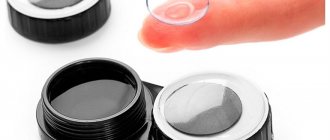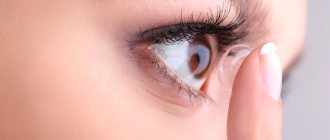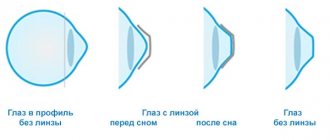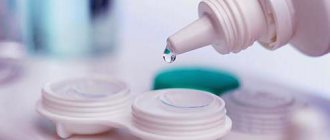Why is it important to store lenses in multifunctional solution?
Manufacturers of contact optics and ophthalmologists talk about the need to store lenses in special plastic containers filled with cleaning solutions.
The most convenient to use are multifunctional solutions that perform several important functions in the care of optical products.
- Removing contaminants.
Thorough cleaning of the surface from dust, microbes, and contaminants of any type is one of the main tasks facing a multifunctional solution. Using this product, at the first stage of cleansing, you can remove up to 90% of surface contaminants.
- Disinfection.
Contact lenses come into contact with the mucous membrane of the eyes, which is very vulnerable to various pathogens. Therefore, it is very important to wear lenses that are sterile and will not allow infection to enter the eyes. Multifunctional solutions contain components that destroy up to 100% of bacteria, fungi and other pathogenic microorganisms. To achieve maximum disinfecting effect, lenses should be placed in a container with a solution for a period of 4 to 8 hours. That is, storing optical products in a special solution ensures their sterility and safety for the eyes.
- Hydration.
Most multifunctional solutions contain a special moisturizing component. It protects contact optics from drying out, preserves its physical properties, and ensures user comfort when wearing it.
Today, high-quality multifunctional solutions are produced by many large manufacturers. Users especially highlight products such as ReNu Multi-Purpose Solution from Bausch+Lomb, Opti-Free PureMoist from Alcon, Maxima from the Maxima Optics brand. Storage and cleaning products may have different compositions and be suitable for different types of lenses, so it is important to consult an ophthalmologist before purchasing.
Multifunctional solutions guarantee cleanliness, sterility and user comfort of optical products. Therefore, ideally, if you wear lenses, you need to store them correctly.
Unfortunately, there are situations when this is not possible. Therefore, information on where else you can put your lenses is relevant for many.
Where can I put my lenses if I don't have solution?
You forgot to buy a new bottle of multifunctional solution on time, stayed overnight with friends, accidentally spilled your cleaner, were delayed somewhere due to bad weather - this is just a small list of situations when it is not possible to organize the storage of contact lenses according to all the rules.
Where can you temporarily put optical products in this case:
- Saline solution (ready or homemade).
- Artificial tear substitute drops.
Let us immediately note that none of the alternative options provides thorough disinfection of contact optics and can only be used as a temporary measure. As soon as possible, the lenses must be treated according to all the rules and dipped in a multifunctional solution. Only then can they be used safely.
Is it possible to store contact lenses in saline solution?
Saline solution is a 0.9% aqueous solution of sodium chloride. It can be purchased ready-made at any pharmacy or prepared independently from 100 grams of distilled water and 0.9 grams of ordinary salt. The second option is not recommended for people with highly sensitive eyes or a tendency to allergic reactions.
The composition of the prepared saline solution is close to special means for cleaning lenses. However, it lacks a number of enzymes and bactericidal components with disinfectant properties.
Before removing lenses, prepare a storage container and sterilize it. Then pour in enough saline solution to completely cover the optical products. Place the lenses in the container and close the lid tightly.
Can lenses be put in eye drops?
Another acceptable alternative to multifunctional solutions is moisturizing eye drops. They are usually used to treat dry eye syndrome or to improve user comfort while wearing lenses. Such drops do not disinfect optical products, but will help preserve their structure and protect them from drying out.
Some users put their optical products in Taufon or other drops. This option cannot be called optimal. More suitable - “Visine Pure Tear” and analogues.
How to replace lens solution?
Even if you don’t have a special solution for cleaning products at hand, there are substitutes that will do an excellent job of this role.
It is important that alternative methods are safe for the patient, do not cause a feeling of “mote in the eye” and are comfortable to use around the clock.
The most popular options for replacing lens solution:
- Saline solution is the most suitable substitute for lens fluid. This solution for lenses, at home, can replace a special liquid for some time. The container in which the products are placed must be disinfected; you can even boil it first and only then pour in the saline solution. You can store lenses in this product, periodically replacing it with a new one. The container can only be closed when the products are completely under saline solution.
- Some eye drops (such as Visine: Clear Tear) are also used as lens fluid , as they prevent the surface from drying out. The composition includes special components that allow the solution to be disinfected and do not pose a threat to humans.
Is it possible to store lenses in Miramistin?
"Miramistin" and "Chlorhexidine" are popular antiseptics that are found in almost any home medicine cabinet today. In this regard, many people are interested: to disinfect lenses, can they be put, for example, in Miramistin or Chlorhexidine?
Ophthalmologists and manufacturers of contact optics categorically prohibit the use of these preparations for storing lenses.
Firstly, these antiseptics tend to accumulate in protein deposits on the surface of the material, which can lead to a toxic reaction of the visual organs - redness, pain, and lacrimation may occur. If these drugs remain on the mucous membrane for a long time, a burn to the cornea is possible. Secondly, they can spoil the structure of the product itself, which will affect its optical and practical properties.
What is chlorhexidine?
This substance is an antiseptic. It is mainly used for leather processing. It is not intended for storing contact optics. Initially, people bought saline solutions based on sodium chloride for this. Later, disinfectants appeared, to which chlorhexidine was added in a small concentration (0.006%) in combination with other disinfecting components. Today this substance is not used in the production of lens care products, as it promotes the accumulation of protein deposits.
Hydrogel contact optics are created from materials that are often resistant to proteins and lipids. However, it needs to be treated daily. Chlorhexidine cannot provide high-quality cleaning. Moreover, it can lead to changes in the structure of ophthalmic products. Even if they have been in this antiseptic for only one night, wearing them is contraindicated. In addition, it should not come into contact with eye tissue. This will cause irritation, redness, watery eyes, etc.
Chlorhexidine is not suitable for lenses in pure or diluted form. If you dilute it with clean water, it will still be harmful to the eyes and contact optics. If you don't have a cleanser, replace it with saline solution for one day. Or buy models that are thrown away after removal.
Where should contact lenses not be stored?
While saline and eye drops are an undesirable but acceptable option for temporarily storing lenses, some products are strictly prohibited from being used for this purpose.
- Water.
Can contact lenses be placed in water overnight? This question interests many users, because in the absence of a solution, ordinary water is the most accessible remedy. However, manufacturers and ophthalmologists say that it contains a huge number of pathogens that settle on the lenses and can contribute to the development of eye infections. It is for this reason that you should not even rinse your lenses with water, either tap water or boiled water.
The only acceptable option is distilled water, but after it, optical products must be disinfected in any case.
- Saliva.
On Internet forums you can find the most unusual advice on the topic “What else can replace special liquids for storing lenses.” Some people advise using your own saliva: supposedly its composition is natural to the body and cannot harm the eyes. Doctors refute this myth and say that saliva contains a huge number of microbes that can cause infection.
- Hydrogen peroxide.
Many users reason like this: there are special peroxide cleaners for contact optics, which means hydrogen peroxide is suitable for storing lenses. Ophthalmologists explain that special cleaners contain hydrogen peroxide in small proportions. Also, after cleaning, the peroxide in these solutions is neutralized in a special way so as not to harm the eyes or cause a burn to the cornea. If you store your lenses in regular hydrogen peroxide and then don't rinse them thoroughly enough, you may end up with a serious chemical burn.
What if you leave your lenses in chlorhexidine overnight?
Even a tiny dose of chlorhexidine in a special liquid can lead to negative consequences. If you immerse lenses in such a solution, you can disrupt the structure of the material and simply ruin them. And what can we say about the eyes: even if a small amount of the drug remains on the surface, you can at least get irritation, and at most, a burn to the cornea.
Chlorhexidine: instructions for use
There is one nuance in the instructions for the drug that must be taken into account. The manufacturer writes that if it gets on the mucous membranes of the eye, you should quickly and thoroughly rinse them with running water.
Daily lenses for those who constantly forget about the solution
If you often find yourself in a situation where you don’t know where to put your lenses and what you can use to replace the multifunctional solution, it’s better to switch to one-day optical products. Their main advantage is single use throughout the day.
In the evening, you just need to throw away such lenses, and in the morning open the blister with a new, sterile pair. Using one-day contact correction products, you do not need to think about cleaning them or storing them correctly. Accordingly, the question of where to store lenses if there is no solution becomes irrelevant.
Why is it not advisable to use such storage options for a long time?
Despite the fact that it is possible to preserve the lenses, they are still susceptible to unwanted influences. CLs can change in size, which causes discomfort; moreover, the diopter of the lens is transformed, and vision is scattered. When the focus changes, the device becomes virtually useless.
Long-term use of substitutes negatively affects the condition of the lenses, and there is an accumulation of pathogenic bacteria. Often the eyes begin to water heavily when putting on contact lenses; redness and sometimes itching or burning may occur.










